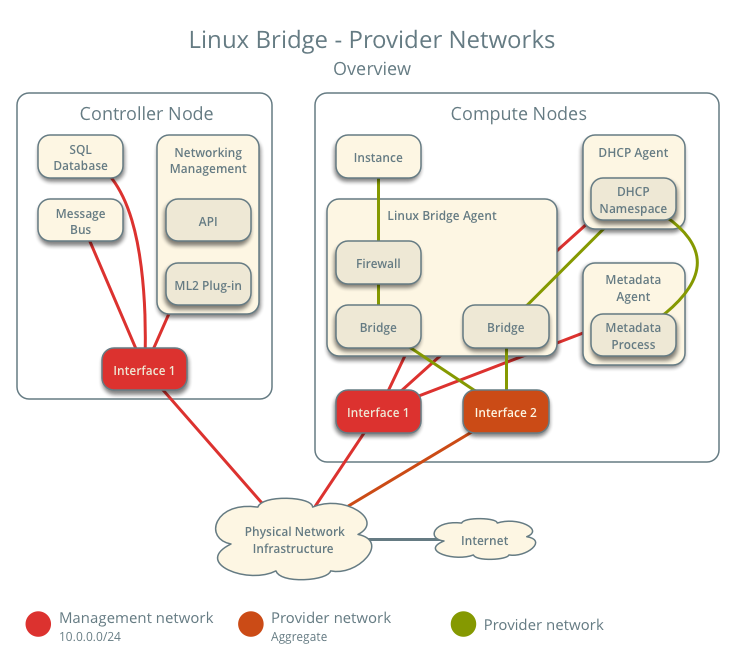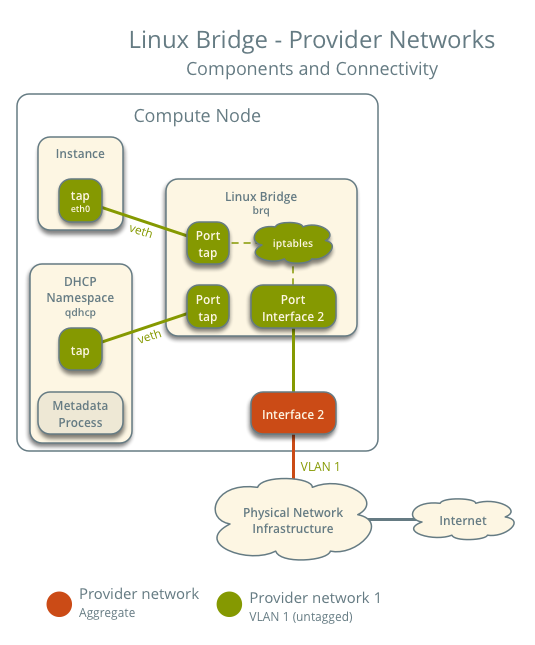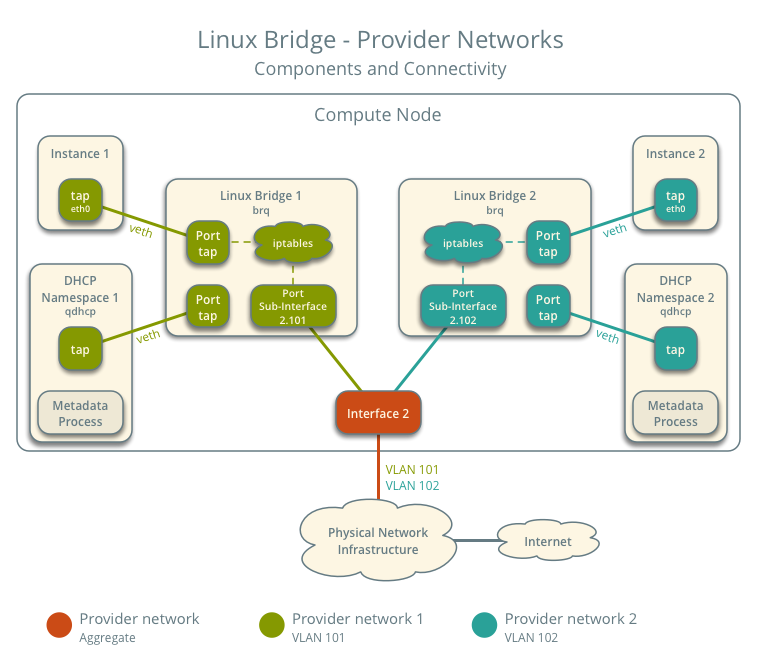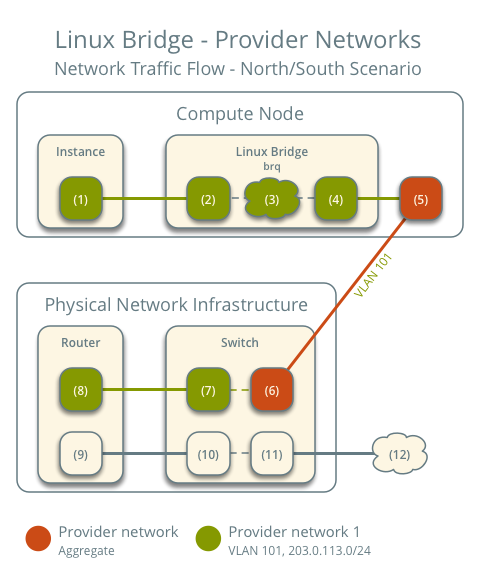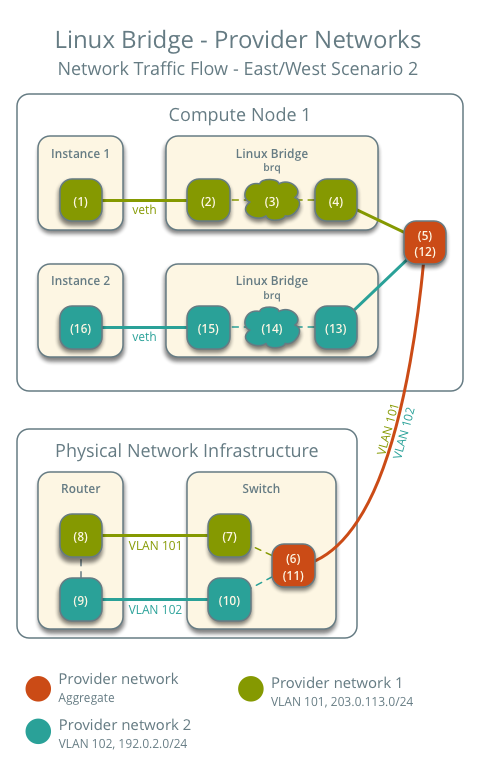Update the response of openstack network agent list Change-Id: Idbc6cb24ffa0ff58eb5a67fd83508184310baac5
13 KiB
Linux bridge: Provider networks
The provider networks architecture example provides layer-2
connectivity between instances and the physical network infrastructure
using VLAN (802.1q) tagging. It supports one untagged (flat) network and
and up to 4095 tagged (VLAN) networks. The actual quantity of VLAN
networks depends on the physical network infrastructure. For more
information on provider networks, see intro-os-networking-provider.
Prerequisites
One controller node with the following components:
- Two network interfaces: management and provider.
- OpenStack Networking server service and ML2 plug-in.
Two compute nodes with the following components:
- Two network interfaces: management and provider.
- OpenStack Networking Linux bridge layer-2 agent, DHCP agent, metadata agent, and any dependencies.
Note
Larger deployments typically deploy the DHCP and metadata agents on a subset of compute nodes to increase performance and redundancy. However, too many agents can overwhelm the message bus. Also, to further simplify any deployment, you can omit the metadata agent and use a configuration drive to provide metadata to instances.
Architecture
The following figure shows components and connectivity for one untagged (flat) network. In this particular case, the instance resides on the same compute node as the DHCP agent for the network. If the DHCP agent resides on another compute node, the latter only contains a DHCP namespace and Linux bridge with a port on the provider physical network interface.
The following figure describes virtual connectivity among components for two tagged (VLAN) networks. Essentially, each network uses a separate bridge that contains a port on the VLAN sub-interface on the provider physical network interface. Similar to the single untagged network case, the DHCP agent may reside on a different compute node.
Note
These figures omit the controller node because it does not handle instance network traffic.
Example configuration
Use the following example configuration as a template to deploy provider networks in your environment.
Controller node
Install the Networking service components that provides the
neutron-serverservice and ML2 plug-in.In the
neutron.conffile:Configure common options:
Disable service plug-ins because provider networks do not require any. However, this breaks portions of the dashboard that manage the Networking service. See the latest Install Tutorials and Guides for more information.
[DEFAULT] service_plugins =Enable two DHCP agents per network so both compute nodes can provide DHCP service provider networks.
[DEFAULT] dhcp_agents_per_network = 2If necessary,
configure MTU <config-mtu>.
In the
ml2_conf.inifile:Configure drivers and network types:
[ml2] type_drivers = flat,vlan tenant_network_types = mechanism_drivers = linuxbridge extension_drivers = port_securityConfigure network mappings:
[ml2_type_flat] flat_networks = provider [ml2_type_vlan] network_vlan_ranges = providerNote
The
tenant_network_typesoption contains no value because the architecture does not support self-service networks.Note
The
providervalue in thenetwork_vlan_rangesoption lacks VLAN ID ranges to support use of arbitrary VLAN IDs.
Populate the database.
# su -s /bin/sh -c "neutron-db-manage --config-file /etc/neutron/neutron.conf \ --config-file /etc/neutron/plugins/ml2/ml2_conf.ini upgrade head" neutronStart the following services:
- Server
Compute nodes
Install the Networking service Linux bridge layer-2 agent.
In the
neutron.conffile, configure common options:In the
linuxbridge_agent.inifile, configure the Linux bridge agent:[linux_bridge] physical_interface_mappings = provider:PROVIDER_INTERFACE [vxlan] enable_vxlan = False [securitygroup] firewall_driver = iptablesReplace
PROVIDER_INTERFACEwith the name of the underlying interface that handles provider networks. For example,eth1.In the
dhcp_agent.inifile, configure the DHCP agent:[DEFAULT] interface_driver = linuxbridge enable_isolated_metadata = True force_metadata = TrueNote
The
force_metadataoption forces the DHCP agent to provide a host route to the metadata service on169.254.169.254regardless of whether the subnet contains an interface on a router, thus maintaining similar and predictable metadata behavior among subnets.In the
metadata_agent.inifile, configure the metadata agent:[DEFAULT] nova_metadata_host = controller metadata_proxy_shared_secret = METADATA_SECRETThe value of
METADATA_SECRETmust match the value of the same option in the[neutron]section of thenova.conffile.Start the following services:
- Linux bridge agent
- DHCP agent
- Metadata agent
Verify service operation
Source the administrative project credentials.
Verify presence and operation of the agents:
$ openstack network agent list +--------------------------------------+--------------------+----------+-------------------+-------+-------+---------------------------+ | ID | Agent Type | Host | Availability Zone | Alive | State | Binary | +--------------------------------------+--------------------+----------+-------------------+-------+-------+---------------------------+ | 09de6af6-c5f1-4548-8b09-18801f068c57 | Linux bridge agent | compute2 | None | True | UP | neutron-linuxbridge-agent | | 188945d1-9e70-4803-a276-df924e0788a4 | Linux bridge agent | compute1 | None | True | UP | neutron-linuxbridge-agent | | e76c440d-d5f6-4316-a674-d689630b629e | DHCP agent | compute1 | nova | True | UP | neutron-dhcp-agent | | e67367de-6657-11e6-86a4-931cd04404bb | DHCP agent | compute2 | nova | True | UP | neutron-dhcp-agent | | e8174cae-6657-11e6-89f0-534ac6d0cb5c | Metadata agent | compute1 | None | True | UP | neutron-metadata-agent | | ece49ec6-6657-11e6-bafb-c7560f19197d | Metadata agent | compute2 | None | True | UP | neutron-metadata-agent | +--------------------------------------+--------------------+----------+-------------------+-------+-------+---------------------------+
Create initial networks
Verify network operation
Network traffic flow
North-south scenario: Instance with a fixed IP address
- The instance resides on compute node 1 and uses provider network 1.
- The instance sends a packet to a host on the Internet.
The following steps involve compute node 1.
- The instance interface (1) forwards the packet to the provider
bridge instance port (2) via
vethpair. - Security group rules (3) on the provider bridge handle firewalling and connection tracking for the packet.
- The VLAN sub-interface port (4) on the provider bridge forwards the packet to the physical network interface (5).
- The physical network interface (5) adds VLAN tag 101 to the packet and forwards it to the physical network infrastructure switch (6).
The following steps involve the physical network infrastructure:
- The switch removes VLAN tag 101 from the packet and forwards it to the router (7).
- The router routes the packet from the provider network (8) to the external network (9) and forwards the packet to the switch (10).
- The switch forwards the packet to the external network (11).
- The external network (12) receives the packet.
Note
Return traffic follows similar steps in reverse.
East-west scenario 1: Instances on the same network
Instances on the same network communicate directly between compute nodes containing those instances.
- Instance 1 resides on compute node 1 and uses provider network 1.
- Instance 2 resides on compute node 2 and uses provider network 1.
- Instance 1 sends a packet to instance 2.
The following steps involve compute node 1:
- The instance 1 interface (1) forwards the packet to the provider
bridge instance port (2) via
vethpair. - Security group rules (3) on the provider bridge handle firewalling and connection tracking for the packet.
- The VLAN sub-interface port (4) on the provider bridge forwards the packet to the physical network interface (5).
- The physical network interface (5) adds VLAN tag 101 to the packet and forwards it to the physical network infrastructure switch (6).
The following steps involve the physical network infrastructure:
- The switch forwards the packet from compute node 1 to compute node 2 (7).
The following steps involve compute node 2:
- The physical network interface (8) removes VLAN tag 101 from the packet and forwards it to the VLAN sub-interface port (9) on the provider bridge.
- Security group rules (10) on the provider bridge handle firewalling and connection tracking for the packet.
- The provider bridge instance port (11) forwards the packet to the
instance 2 interface (12) via
vethpair.
Note
Return traffic follows similar steps in reverse.
East-west scenario 2: Instances on different networks
Instances communicate via router on the physical network infrastructure.
- Instance 1 resides on compute node 1 and uses provider network 1.
- Instance 2 resides on compute node 1 and uses provider network 2.
- Instance 1 sends a packet to instance 2.
Note
Both instances reside on the same compute node to illustrate how VLAN tagging enables multiple logical layer-2 networks to use the same physical layer-2 network.
The following steps involve the compute node:
- The instance 1 interface (1) forwards the packet to the provider
bridge instance port (2) via
vethpair. - Security group rules (3) on the provider bridge handle firewalling and connection tracking for the packet.
- The VLAN sub-interface port (4) on the provider bridge forwards the packet to the physical network interface (5).
- The physical network interface (5) adds VLAN tag 101 to the packet and forwards it to the physical network infrastructure switch (6).
The following steps involve the physical network infrastructure:
- The switch removes VLAN tag 101 from the packet and forwards it to the router (7).
- The router routes the packet from provider network 1 (8) to provider network 2 (9).
- The router forwards the packet to the switch (10).
- The switch adds VLAN tag 102 to the packet and forwards it to compute node 1 (11).
The following steps involve the compute node:
- The physical network interface (12) removes VLAN tag 102 from the packet and forwards it to the VLAN sub-interface port (13) on the provider bridge.
- Security group rules (14) on the provider bridge handle firewalling and connection tracking for the packet.
- The provider bridge instance port (15) forwards the packet to the
instance 2 interface (16) via
vethpair.
Note
Return traffic follows similar steps in reverse.
